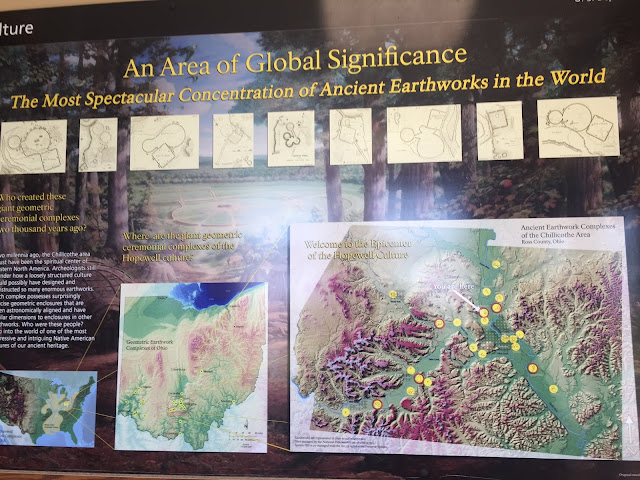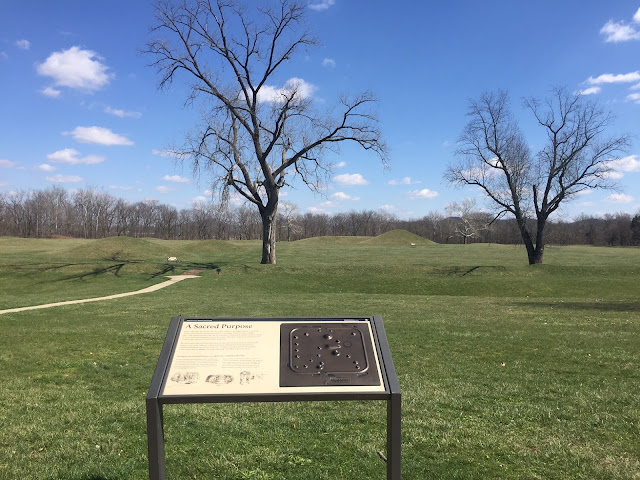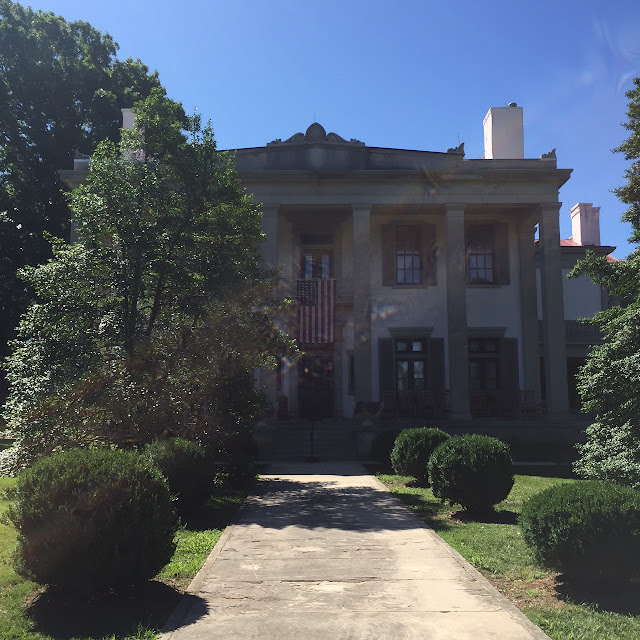Southern Ohio - an Area of Global Significance?
You wouldn't expect an area between two correctional institutes outside a small city in Southern Ohio to be an area of Global Significance. But it is. If you travel to Chillicothe in South-Central Ohio and travel State Route 104, you will come to the Hopewell Culture National Historic Park. At this very unassuming and small Visitor Center, you would be at the center of the "most spectacular concentration of Ancient Earthworks in the World." Yes, the world.
The term Hopewell encompasses several different Native American groups of differing economic, spiritual and political beliefs who lived in this area from 200 B.C. to A.D. 500. The main characteristic that all these peoples have in common was "construction of earthen walls and mounds of various shapes and sizes." They were the Mound Builders.
And if you visit the Hopewell Culture National Historic Park you would be fascinated by their history. The Visitor Center includes a 20 minute film explaining the history of the Mound Builders, a small museum with artifacts from archeological digs here and a small bookstore. Then you can walk on the trails and paths to see the Mounds themselves.
People of the Hopewell Culture seettled along waterways - such as the Scioto River here - and lived in very small settlements. Usually only a few houses per area. Rather than hunters, these peoples were more agricultural and started some of the first Native American farming. They were largely into trading and archeological digs of the mounds found marine shells, copper and mica - which could only have been found outside of this area. Archeologists believe that there was a trading route set up all across what is now the U.S. and southern Canada known as the Hopewell Exchange System.
Earthworks and burial mounds were the trademark of the Hopewell peoples. Earthworks were geometrical complexes and conical mounds. In the photo above, at the bottom left, the circle would fit inside the square and the square inside the large orange structure. All of these mounds were exactly the same no matter where they were built - be it Southern Ohio or northern Wisconsin. Mounds could take decades to build and were built through filling container after container with earth and dumping them until they had a mound. Sometimes 20 or 30 years worth of earth dumping.
Generally, these mounds were used for religious practices or funerals. We know this because of archeological digs which uncovered funeral pyres with some bodies stacked with mica in between - which might have been those of higher caste in the society. This mound, pictured above, was filled with over 200 effigy pipes - which were believed to be smoked during funeral services - carved in the likeness of animals. Other artifacts found were artwork and pottery.
At the Mound City Group in Chillicothe there is an earthen wall around the mounds.
Some historians and archeologists believe that the mounds also were encoded to sunrises, sunsets, equinoxes, solstices and were lunar observatories.
Unfortunately, over the years many mounds were destroyed due to farming practices - farmers thought they were a huge nuisance - or just because they weren't thought to be important. During the War of 1812, this area became a Prisoner of War camp. In the 1840's two surveyors - Ephraim Squire and Edwin Davis - began the important work of documenting the mounds and the Hopewell culture. In June of 1917, Chillicothe would become the home of Camp Sherman and the population would swell from 16,000 to 60,000. Barracks had to be built - and quickly - but luckily some men from the Ohio Historical Society were able to talk the government into building the buildings around the mounds - though some were inadvertently destroyed.
What it looked like in 1846
Today you can visit Hopewell National Historical Park and walk the mounds. It seems to be a place forgotten about in modern times. But that makes it no less fascinating to me. I realize this isn't a bucket list, top travel site so you wouldn't plan a trip here just to see these mounds - and if it was to you, you probably have already seen them - but if you're traveling through Southern Ohio, it's worth a stop. See where some of North American civilization began.
Follow me on: Instagram/Facebook
This post is part of a link-up with: Travel Photo Thursday at Budget Travelers Sandbox, Weekend Travel Inspiration at Reflections Enroute, The Weekly Postcard at Travel Notes and Beyond and The Weekend Travel Blog Party!
The term Hopewell encompasses several different Native American groups of differing economic, spiritual and political beliefs who lived in this area from 200 B.C. to A.D. 500. The main characteristic that all these peoples have in common was "construction of earthen walls and mounds of various shapes and sizes." They were the Mound Builders.
And if you visit the Hopewell Culture National Historic Park you would be fascinated by their history. The Visitor Center includes a 20 minute film explaining the history of the Mound Builders, a small museum with artifacts from archeological digs here and a small bookstore. Then you can walk on the trails and paths to see the Mounds themselves.
People of the Hopewell Culture seettled along waterways - such as the Scioto River here - and lived in very small settlements. Usually only a few houses per area. Rather than hunters, these peoples were more agricultural and started some of the first Native American farming. They were largely into trading and archeological digs of the mounds found marine shells, copper and mica - which could only have been found outside of this area. Archeologists believe that there was a trading route set up all across what is now the U.S. and southern Canada known as the Hopewell Exchange System.
Earthworks and burial mounds were the trademark of the Hopewell peoples. Earthworks were geometrical complexes and conical mounds. In the photo above, at the bottom left, the circle would fit inside the square and the square inside the large orange structure. All of these mounds were exactly the same no matter where they were built - be it Southern Ohio or northern Wisconsin. Mounds could take decades to build and were built through filling container after container with earth and dumping them until they had a mound. Sometimes 20 or 30 years worth of earth dumping.
Generally, these mounds were used for religious practices or funerals. We know this because of archeological digs which uncovered funeral pyres with some bodies stacked with mica in between - which might have been those of higher caste in the society. This mound, pictured above, was filled with over 200 effigy pipes - which were believed to be smoked during funeral services - carved in the likeness of animals. Other artifacts found were artwork and pottery.
At the Mound City Group in Chillicothe there is an earthen wall around the mounds.
Some historians and archeologists believe that the mounds also were encoded to sunrises, sunsets, equinoxes, solstices and were lunar observatories.
Unfortunately, over the years many mounds were destroyed due to farming practices - farmers thought they were a huge nuisance - or just because they weren't thought to be important. During the War of 1812, this area became a Prisoner of War camp. In the 1840's two surveyors - Ephraim Squire and Edwin Davis - began the important work of documenting the mounds and the Hopewell culture. In June of 1917, Chillicothe would become the home of Camp Sherman and the population would swell from 16,000 to 60,000. Barracks had to be built - and quickly - but luckily some men from the Ohio Historical Society were able to talk the government into building the buildings around the mounds - though some were inadvertently destroyed.
What it looked like in 1846
Today you can visit Hopewell National Historical Park and walk the mounds. It seems to be a place forgotten about in modern times. But that makes it no less fascinating to me. I realize this isn't a bucket list, top travel site so you wouldn't plan a trip here just to see these mounds - and if it was to you, you probably have already seen them - but if you're traveling through Southern Ohio, it's worth a stop. See where some of North American civilization began.
Follow me on: Instagram/Facebook
This post is part of a link-up with: Travel Photo Thursday at Budget Travelers Sandbox, Weekend Travel Inspiration at Reflections Enroute, The Weekly Postcard at Travel Notes and Beyond and The Weekend Travel Blog Party!




















I liked seeing what it looked like in 1846! Thanks for joining up with Travel Photo Thursday.
ReplyDeleteMe too! Thanks for visiting, Jan!
DeleteI never knew of this place before. There is so much of past cultures and civilisations that we don't know. Perhaps this is the native American version of Stonehenge?
ReplyDeleteGood interpretation! They did use them for all kinds of ceremonies linked to the sun and moon like Stonehenge. A unique place very few have heard about. Thanks for visiting, Rhonda!
DeleteInteresting! There are two other mound locations that are UNESCO World Heritage Sites: Cahokia Mounds State Historic Site in Missouri and Monumental Earthworks of Poverty Point in Louisiana, so the practice was quite widespread. It's a fascinating phenomenon, isn't it?
ReplyDeleteI've not been to either of the others. This one touts itself as the largest grouping of mounds in the world though the part I visited was just a teeny, tiny bit of it. There are mounds all over southern Ohio apparently but this is the grouping that has a visitor center. It is fascinating!
DeleteThose interpretation boards are an excellent way of interpreting the landscape and finding out about the ancient cultures - I wish more places would do such high quality ones. Fascinating place. #Wkendtravelinspiration
ReplyDeleteThe visitor centre is small but very comprehensive about what is known about the area. The film and museum were very well put together.Thanks for visiting The Unpaved Road!
DeleteFascinating, I've been to Cahokia but not here. To be honest I didn't even know these existed. I guess it was more widespread than I thought. Thanks for sharing with the #wkendtravelinspiration!
ReplyDeleteA pretty surprising and fascinating little place - though the mounds are incredibly widespread the historical park is very small. Thanks for visiting, Jim!
DeleteNow, this is something else! I do not know a lot about these places but when I was in college I did some research with respect to areas like that. Other researches were using radars to try to decipher what is underneath mounds like these. Our job was to process the signals to see if other were able to create an image from it. Sad part, we never saw the final product. Because of that, I would like to see a place like this one day. #TPThursday
ReplyDeleteThat is very interesting, Ruth! I wish you could've seen the final product! But what a cool idea to see if radar could detect what is inside instead of excavating - and since there are so many to decipher then it seems it could cut down on the work load. Thanks for sharing and for visiting The Unpaved Road!
Delete